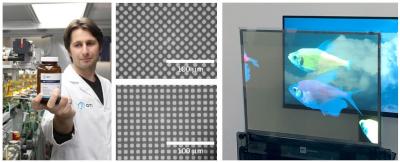Canada-based OTI Lumionics developed innovative OLED materials and technologies. In August 2020 the company announced that it will start shipping its 2nd-gen ConducTorr Cathode Patterning Materials (CPM) by the end of 2020 to customers, which will use these to create OLED displays with under-the-display camera and face unlock technologies.

We had a short talk with the company's founder and CEO, Dr. Michael G. Helander, during which we discussed the company's technology, status and future plans.
Q: Hello Michael. Can you share the latest materials you are developing and supplying?
We continue to develop and supply our second generation of Cathode Patterning Materials⢠(CPMâ¢) for OLED displays. This second-generation of materials are compatible with existing cathode materials like MgAg and metal based EIL layers like Yb. Within our product line of second-generation CPMâ¢materials we have several different product offerings that are targeted at different customer applications and specifications. We are also working on third-generation CPM⢠that will expand compatibility to other metals like copper, which opens new market opportunities outside of the OLED display for the technology.
Q: In August 2020, OTI announced it will start shipping its ConducTorr CPM materials by the end of 2020. Are these materials shipping now? Is there any commercial smartphone display before UDC that uses your materials?
Yes, we have been shipping our second-generation CPM⢠materials to panel makers in Korea and China since the second half of last year. The materials have been successfully validated by multiple panel makers in OLED display module tests in their Gen 4.5 lines for a variety of applications, including, but not limited to, under panel camera, under panel IR sensors, and camera blind hole. Modules from these pilot tests have been sampled to a variety of OEM device makers for testing and integration.
We are now shipping materials at a large quantity to multiple panel makers for the final stages of panel makers design-in mass production qualification in their Gen 6 production lines. We anticipate product announcements from customers after completion of this final stage of design-in, which is expected to be completed in the second half of this year.
Q: Are there any plans to launch larger (laptop/monitor) OLEDs with Under-The-OLED cameras?
Absolutely. We have seen a strong increase in demand for under panel cameras and under panel IR sensors from OEM device makers for laptop and IT applications over the last year. With the renewed focus on business computers for WFH and video conferencing there is renewed emphasis on improved user experiences for video calls which necessitates moving the camera away from the bezel and towards the center of the display by moving the camera under the display. Also, because of the lower resolution of larger displays it is in fact significantly easier to implement an under-panel camera or IR sensor compared to a high-resolution mobile display.
Q: Will OTI materials' be adopted in future transparent OLEDs, to create higher transparency? Any update on that?
Yes, we have customers working on applying CPM⢠to improve the transparency of future transparent OLED displays. Given that transparent OLED displays are still a niche market, customers are focused on bringing the technology to market first in mobile devices in the form of under panel cameras and IR sensors. We don’t have any customer timelines to share currently.

Q: OTI's materials can also be used to enhance the brightness (or efficiency) of OLEDs. Can you tell us more about that?
There are several ways that panel makers are working on applying our technology to enhance display brightness and efficiency. For example, the optimal cathode thickness for red, green and blue emitters is not the same. Ideally the thickness for red should be greater than green which is greater than blue. However, since blue is the weakest link and the cathode is a common layer, the thickness gets optimized for blue. By increasing the thickness of the cathode, the efficiency of red can be increased to 150-180%, resulting in double digits improvements in panel level efficiency and/or brightness.
Using CPM⢠deposited on top of the cathode to mask the blue sub-pixel allows a second cathode deposition to increase the local thickness of the cathode for red and/or green sub-pixels. This approach has been demonstrated by customers to increase efficiency/brightness without negatively impacting color coordinate or viewing angle.
Q: OTI received a strategic investment from LG Display. Can you share any joint projects with LGD?
Unfortunately, we are not able to discuss specific customer projects which are confidential. As one of the leading display manufacturers LGD is of course an important customer, who we have a long history of fruitful collaboration with.

